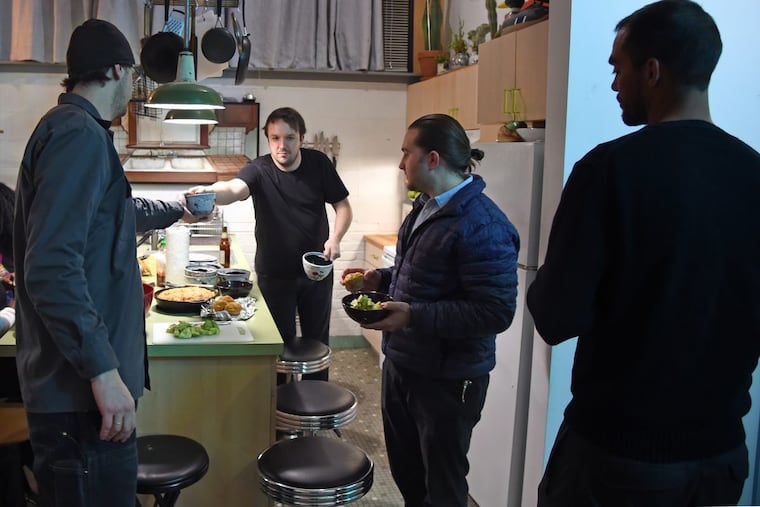Globe Dye Works: How a former Frankford factory welcomed work and housing
Among businesses and nonprofits, nearly 20 people live in this former textile factory.

Inside the Globe Dye Works, just off the lobby, artists Joe Leroux and Stacey Lee Webber have set up shop. Through the entrance, in the center of their space, there's a wood shop and, past that, a showroom with their work. Walk a little farther, and you can spot their washing machine under a table with metalworking equipment. Webber, while giving a tour, pointed out, "There's my jewelry station, and then my treadmill."
The couple have worked — and lived — at Globe Dye Works for six years. The sprawling, post-industrial Frankford property was a hub for yarn dyeing and textile-related trades from 1865 until it closed in 2005 under a fifth-generation owner. A partnership of developers, the Globe Development Group, bought the complex in 2007 and has been incrementally renovating it since.
It's an example of an emerging trend in this old manufacturing hub: workers can skip the commute altogether, and mix business with leisure as they please.
The property owners aren't too crazy about the hipster term "makerspace." That word doesn't encompass the environmental justice nonprofit, the food businesses, the wooden boat-building youth program, the high-end florist, or the 14,000-square-foot vintage car dealership that cohabitate in the sprawling brick behemoth on Torresdale Avenue. There are 36 tenants in the Globe, and 19 people call it home.
The complex is the most prominent example of what changes to the city zoning code allow: a mix of commercial and the lightest industrial uses with housing. Many Philadelphia warehouses with such zoning remain undeveloped. Bok, the makers' center in South Philadelphia, has the same zoning, but no one lives there. The Becker Building in Northern Liberties does too, offering apartments, but no businesses.
So far, Globe hasn't created divisions in the neighborhood. Bob Smiley, editorial director of the Frankford Gazette, hasn't heard of any gentrification-related complaints, just concerns over parking.
Jennifer Bradley of the Aspen Institute said Globe's community is in step with urban trends. "New urban making and manufacturing is smaller, cleaner. It's artisanal," she said. "Those kinds of making are incredibly well-suited to urban life."
Still, the blend of residential and light industrial remains unusual nationally. "That is still something that's being tested in cities," said Lee Wellington, executive director of the Urban Manufacturing Alliance.
A few cities, among them Indianapolis and Nashville, have introduced "artisan zoning." "When you achieve that delicate balance, and it is delicate, you achieve this diverse economic ecosystem," Wellington said. The challenge, experts say, is to make sure such spaces are safe and up to code.
Globe tenants describe managing partners Pete Kelly and Charlie Abdo, who opened the North Star Bar in Fairmount, as conscientious landlords who regularly, when rehabilitating dilapidated parts of the compound, customize them for new renters.
Jonathan Adams, co-owner of Rival Bros. Coffee, where a new tasting room was built in the factory's roof trusses above an office, said Abdo and Kelly have a "dad-like" presence. His company also often turns to other tenants for help, a common practice in the Globe. "There's so much mechanical creativity here," said Adams. "So many problems have been resolved in these walls."
On a recent weekday evening, Webber and Leroux had a group of tenants over for dinner and drinks. At day's end, residents often gather to hang out or cook for one another or even, among the musically inclined, jam together.
"Does anyone want margaritas?" Webber asked.
Ken Derengowski headed off to grab a bottle, walking through a boiler room the developers intend to turn into an events space, through to another building where his apartment is. A metalsmith, he's one half of a Globe couple. He would regularly run into Allegra Fasnacht, co-owner of Birch Tree Catering, after her events. She knew they had some chemistry because after their first date she quit smoking. Now, they share a last name and a large, open space. Their daughter, Nora, 3, sleeps next door to the metal-workings studio.
Derengowski walked past his sculptures, his gem-faceting machine, and Nora's playspace until he was in the kitchen, reaching for a bottle of Sauzon tequila. Back at Webber and Leroux's place, he sat with his neighbors, who were fighting the January freeze with bowls of chili over pasta — they're Midwestern.
Globe artists and artisans say there's a certain pleasure when you don't have to schlep to a studio or workshop when late-night inspiration strikes.
"I think it takes a certain type of person to live like this," Ken Derengowski said.
Webber agreed, "Yeah, it's so efficient," adding that she's more productive this way. But then she noted, "It's hard to network."
With neighbors able to turn to one another for everything from business partnerships to company, the community can be insular. Rumack said they often go to the local Applebee's, but much of the time, they stay in.
Ken Derengowski thinks that could be because of the long hours they put in, too. Added Allegra Derengowski: "None of us are rolling in it, either."
Wayne Humphrey II wouldn't call it slavery, he told the gathering, but he said he does work nonstop. He is a contractor, event producer, charity craft brewer, and president of the Morris Animal Refuge. He said that sometimes, pulling back from work felt like leaving a child unattended — too many things can go wrong.
Rumack thought of his own loft. "I always want to expand my work space," he said, "and I'll compromise my living space. "I have 3,000 square feet; my bedroom is like 150."